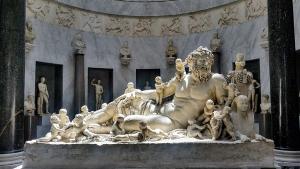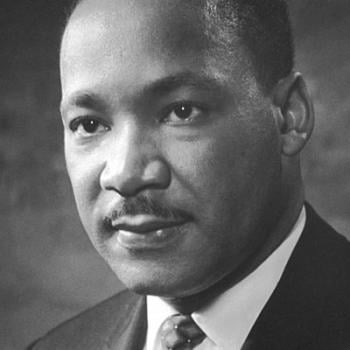
My Patheos colleague “Fellow Dying Inmate” has been writing a fascinating series of posts on the development of monotheism in Christianity. FDI rightly challenges the common assumption (among Jews and Muslims as well as Christians) that monotheism goes all the way back to Abraham. He points out that for much of the Old Testament YHWH is referred to as the God of Israel, to whom Israel is called to be faithful, rather than as the one and only God who exists. Most sections of the OT treat other gods as real rivals to YHWH, though ultimately ineffectual compared to Him.
The terms “henotheism” and “monotheism,” though, are abstract concepts that can obscure more than they clarify, unless we define them carefully. So in this post I’ll be describing what I think the distinction is, and how I understand the development of Christian monotheism.
Biblical henotheism
FDI argues that not only the Old Testament but also the New generally proclaims “henotheism” rather than “monotheism.” What he seems to mean by this, at least in the NT context, is a hierarchy of beings with the God of Israel at the top. So FDI acknowledges that the NT writers believed that the one God of Israel was the creator of the cosmos. (As, of course, did the author of Genesis 1 and the authors of several other texts in the OT.) He was not just one god among many who were essentially equal.
I would tend to use the term “henotheism” only for the worship of one god among other gods, where all the gods are seen as beings of basically the same kind. I do not see that view in the New Testament. Nor does the final canonical form of the OT, as a whole, present that view. (Parts of the Old Testament certainly do.)
To my mind, the break between henotheism and monotheism comes in the later stages of the redaction of the Torah and in the later prophets, around the time of the Babylonian Exile. That’s the point when authors such as “Second Isaiah” and the author of Genesis 1 make the case that YHWH is in fact the one Creator. Second Isaiah, in fact, may believe that the other gods don’t exist at all, though Isaiah 40-55 can be read in other ways.
The radical metaphysic of classical Christian theology
That doesn’t mean, though, that this early “monotheism” was identical to developed Christian monotheism. From the fourth century on, Christian theologians have claimed that there is an infinite metaphysical difference between God and all creatures. The difference is infinite because God is infinite.
This is a radical Christian metaphysical claim. For Aristotle and other pagan Greek philosophers, infinity is a form of imperfection. It is chaotic, formless. Perfection consists in having just the right shape. Origen agreed. He taught that God created just as much universe as he could manage.
But in the fourth century, Gregory of Nyssa articulated the doctrine that God’s perfection, God’s power, God’s goodness, are infinite. And because they are infinite, God is fundamentally other than creation. God is not the apex of a pyramid. Or if He is, then it’s an apex with an infinite gap between the apex and the rest of the structure.
Because God is utterly “other” than Creation, God can, paradoxically, be present to and in all of creation. God is not a being alongside other beings, competing with them. God is the eternal life in which all life lives, the eternal Being in which all being participates.
This theology incorporates elements of the Neoplatonic tradition, of course. Many modern theologians accuse it of being a “Hellenizing” corruption of the Gospel. But the claim of divine infinity, as well as the claim that God created the world out of nothing, are both radically opposed to the entire pagan philosophical tradition. Classical Christian theology, forged in the controversies of the fourth century, spoke in the language of Greek philosophy while introducing, radical, dynamic new concepts into it.
The Logos and the cosmic pyramid
The major controversy of the fourth century concerned the relationship of the divine Logos to the eternal Father. Pre-Nicene “Logos theology” saw the Son as divine in some way but also clearly, in some way, lesser than the Father. There were various ways of trying to deal with the ambiguities of this theology, some of them closer to later orthodoxy and some further away from it.
But all of this pre-Nicene theology fit fairly comfortably within the “pyramid” structure of late ancient religion generally. Pagans believed in a supreme Divine Being, exalted beings called “gods,” and lesser superhuman beings called “demons .” (Or “daemons” if you want to distinguish them from the Christian concept of fallen, entirely evil superhuman beings. But Christians were offering a polemical reinterpretation of pagan demons, so I think using the same term for both is actually less confusing in the long run.)
Jews believed in one God, exalted beings called “angels,” and, again, lesser beings called “demons.” (In Jewish, as in Christian, usage, demons were seen as evil, though Christians emphasized the dualism of angels/demons more than Jews did, I think.) Some ancient Jewish texts refer to an exalted angel called “Metatron” who helped God govern the world and was so glorious that it was easy to mistake him for God.
Christians believed in one God, exalted beings called “angels,” and wholly evil fallen beings called “demons.” They identified both pagan “demons” and pagan “gods” as evil demons. Most Christians did not claim that these beings were simply nonexistent. And above the angels, somehow mediating between the unknowable Father and all of creation, was the Logos, the Word. With the Word was the Holy Spirit. Both Word and Spirit made the Father known to the world, and were actively involved in creation. Irenaeus called the Word and the Spirit the “two hands of God.” Both were in some way divine but also distinct from (and to some extent lesser than) the Father. This is of course a simplification, but something like this was the dominant view as far as we can tell.
Trinity and monotheism
In the fourth century, Arius sought to bring clarity to this rather ambiguous theology by insisting that the Son, like everything else that was not the Father, was created by the Father. The resulting complicated and bitter controversy, which quickly ceased to have anything to do with Arius himself, lasted until at least 381. (Debate continued after that, but from 381 on there was a clearly defined “orthodox” position which had the support of the Empire. To be a Catholic Christian–a member of the mainstream, dominant Christian church–was, from this point on, to be a Trinitarian Christian.)
In the course of this controversy, Catholic Christians reached greater clarity not just about the Son and the Spirit, but about their doctrine of God in general. Hence R. P. C. Hanson dubbed his magisterial study of the controversy The Search for the Christian Doctrine of God. The more they argued about whether the Logos was a creature or not, the more inadequate all attempts to bridge the gap between Creator and creation seemed to be.
Thus, out of a debate over the status of the Logos came a clearer affirmation of the utter transcendence of God. The Logos had to be fully divine, “of one substance with the Father,” because otherwise the Logos would simply be one of the creatures. The Cappadocians, who provided the key ideas that led to the resolution of 381, were also pioneers in the radical Christian metaphysic I’ve described above.
So far from destroying monotheism, as Muslims believe, the development of the doctrine of the Trinity expedited the development of full blown metaphysical monotheism. (And this, in turn, demonstrates the silliness of claiming that Muslims do not worship the same God we do. Their radical monotheism is not a rejection of the true God.) From the fourth century on, orthodox Christians have affirmed the radical ontological difference between God and creation, rather than seeing God as the greatest among beings.
So what about henotheism?
In FDI’s usage, only this full-blown metaphysical monotheism counts as “monotheism.” I prefer a broader definition, because I think FDI’s definition of “henotheism” lumps together things that are quite different from each other. I would restrict the term “henotheism” for the view that the God of Israel is basically the same kind of being as other gods, but the particular god whom Israelites are called to worship.
In fact, I’m not a big fan of the term “henotheism” at all. It’s a term invented by 19th-century German scholars and used to describe rather different things. (Max Müller, for instance, used it for the practice of worshiping a particular deity who was seen as one of many expressions of a common divine essence. That is arguably the opposite of what we are talking about in Biblical religion.) “Monolatry” is perhaps the clearest term for the worship of one god who is seen as one among many.
But once ancient Hebrews began making unique claims for YHWH’s place in the cosmos, I think we can use the term “monotheism” and should distinguish among different kinds of monotheism. “Covenantal monotheism” is one way of speaking about henotheism/monolatry in the Old Testament. the exclusive covenant between YHWH and Israel clearly implied, to the OT writers, that YHWH was indeed something special. They may not have been particularly concerned with YHWH’s metaphysical status. But they clearly believed that this particular deity was worthy of exclusive devotion in a way that other deities were not.
“Creational monotheism” describes the view that YHWH is in fact the creator of the universe, including the other gods. Another way to speak of this would be “hierarchical monotheism”–the idea that the God worshiped by Israel is at the head of a “pyramid” of beings, clearly superior but with the most exalted among them being much more like God than like human beings.
The distinctive claim of the radical metaphysical monotheism of classical Christianity is, in contrast, that even the loftiest angel or “god” is far more like us than like God, because of the infinite qualitative difference between God and any creature.
But of course my disagreement with FDI here is largely semantic. We agree that the understanding of what it means to worship “YHWH your God” as “one Lord” has changed significantly over the centuries. And we agree that as Catholics we should be honest about the reality of historical change.
We are indeed heirs to Abraham, the father of our faith. But this continuity lies in the promise and faithfulness of God, not in our ideas about God. Our theology does not conjure the one God into existence. Rather, God’s sovereign and gracious revelation of Himself provokes us, disturbs us, fills us with longing. And we express that longing in part through the never-ending quest to understand the infinite Reality from whom we come and on whom we depend.












